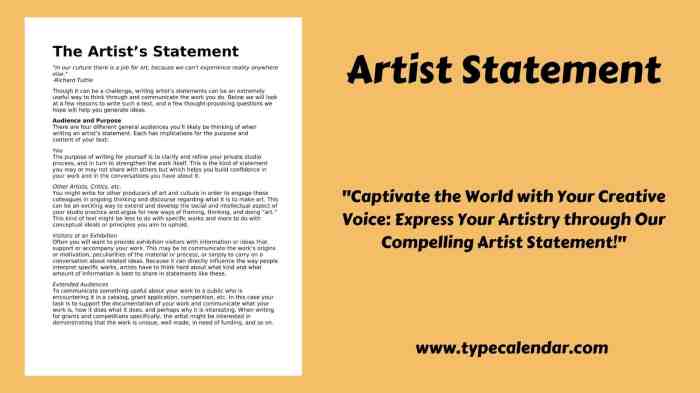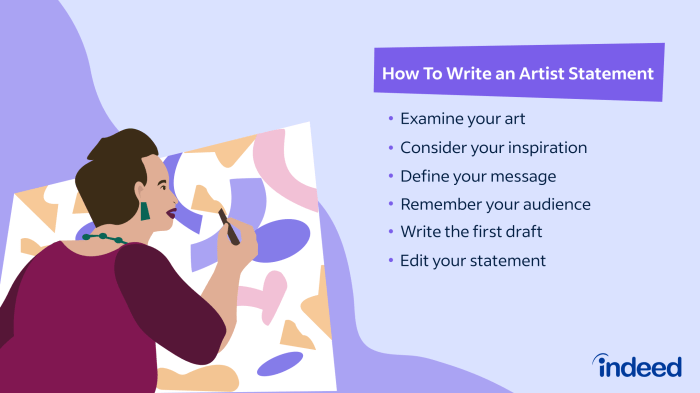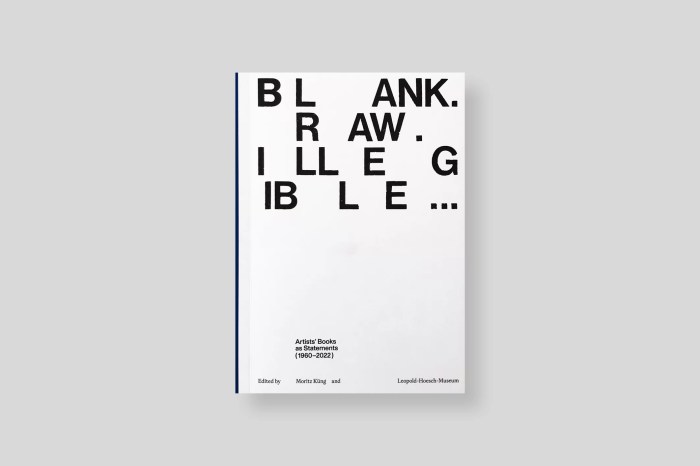Art Manifest: Unpacking the power of artistic declarations, this exploration delves into the history, language, and impact of manifestos across various movements. From the explosive pronouncements of Futurism to the subtle pronouncements of contemporary artists, we’ll examine how these documents shape artistic discourse and influence the very way we understand art.
We’ll dissect the stylistic choices, rhetorical strategies, and symbolic language used to craft these powerful statements. We’ll trace their evolution from historical movements like Dadaism and Surrealism to the digital age, where artists utilize new platforms to express their artistic visions. Prepare for a journey through the compelling narratives and enduring legacies of art manifestos.
Defining “Art Manifesto”
An art manifesto is a public declaration of the intentions, motives, or views of an artist, group of artists, or artistic movement. These documents articulate the principles and philosophies guiding their creative work, often serving as a rallying cry and a framework for understanding their artistic output. They’ve played a crucial role throughout art history, shaping artistic discourse and influencing the evolution of various movements.
Historical Context of Art Manifestos
Art manifestos emerged as a significant form of artistic expression, particularly during periods of rapid social and technological change. The late 19th and early 20th centuries witnessed a surge in their popularity, coinciding with the rise of modernism and various avant-garde movements. These manifestos served as a response to the established artistic norms and sought to redefine the very nature of art itself.
The rise of mass media further amplified their reach and impact.
Examples of Famous Art Manifestos and Their Key Tenets
Several iconic art manifestos have profoundly impacted the art world. The Futurist Manifesto (1909), for instance, celebrated technology, speed, and violence, rejecting traditional artistic values. The Dada Manifesto (1918) championed anti-art, absurdity, and social critique as a response to World War I. The Surrealist Manifesto (1924) explored the subconscious mind and the power of dreams, advocating for automatic writing and unexpected imagery.
These examples highlight the diversity of approaches and aims within art manifestos.
Typical Structure and Components of an Art Manifesto
While there’s no rigid formula, most art manifestos share common structural elements. They typically begin with a bold statement of intent, outlining the movement’s core principles and philosophies. This is often followed by a critique of existing artistic norms or societal structures. The manifesto then proposes alternative approaches, detailing new artistic techniques, styles, or subject matter. Finally, many manifestos include a call to action, urging artists and the public to embrace the movement’s vision.
Comparison of Different Approaches to Writing Art Manifestos
Art manifestos vary significantly in their tone, style, and approach. Some adopt a highly aggressive and polemical stance, aiming to provoke and challenge established conventions. Others take a more measured and analytical tone, presenting their arguments with intellectual rigor. The choice of style often reflects the movement’s overall philosophy and intended audience.
The Language of Art Manifestos
The language employed in art manifestos is a crucial element in their effectiveness. The stylistic choices, rhetorical strategies, and overall tone all contribute to the manifesto’s persuasive power and impact on its readers.
Stylistic Choices in Art Manifestos
Art manifestos often employ bold, declarative sentences, emphasizing the movement’s conviction and urgency. They frequently utilize vivid imagery, metaphors, and symbolism to convey their message powerfully. The use of repetition and parallelism can create a sense of rhythm and momentum, enhancing the manifesto’s rhetorical impact. A concise and impactful style is commonly preferred.
Use of Rhetoric and Persuasive Techniques
Art manifestos frequently employ various rhetorical devices to persuade their readers. These include appeals to emotion (pathos), logic (logos), and authority (ethos). The use of strong verbs, evocative adjectives, and emotionally charged language helps to engage the reader and build support for the movement’s cause. Propaganda techniques may also be employed to sway public opinion.
Impact of Tone and Voice on Effectiveness, Art manifest
The tone and voice of an art manifesto significantly impact its reception. A confrontational and aggressive tone can be effective in challenging the status quo, while a more measured and intellectual tone might appeal to a broader audience. The choice of voice—whether formal or informal, authoritative or conversational—shapes the reader’s perception of the movement and its aims. A consistent voice throughout the manifesto enhances its overall impact.
Examples of Metaphors and Symbolism in Manifestos
Many art manifestos utilize metaphors and symbolism to convey complex ideas concisely and memorably. For example, the Futurist Manifesto’s celebration of speed and technology can be seen as a metaphor for the dynamism and progress of modern society. Similarly, Dada’s use of absurdity and anti-art can be interpreted as a symbolic rejection of the horrors of World War I.
Art Manifestos and Artistic Movements

Art manifestos are intrinsically linked to artistic movements, serving as both a catalyst and a defining document. Understanding the relationship between manifestos and movements provides valuable insight into the evolution of art history.
Comparison of Manifestos from Major Art Movements

| Movement | Key Artists | Manifesto Themes | Impact |
|---|---|---|---|
| Surrealism | André Breton, Salvador Dalí, René Magritte | Subconscious, dreams, automatism, irrationality | Influenced literature, film, and art; explored the unconscious mind |
| Dadaism | Marcel Duchamp, Tristan Tzara, Hugo Ball | Anti-art, absurdity, rejection of reason, social critique | Challenged traditional artistic conventions; influenced performance art and conceptual art |
| Futurism | Filippo Tommaso Marinetti, Umberto Boccioni, Giacomo Balla | Speed, technology, dynamism, violence, rejection of the past | Influenced design, architecture, and film; celebrated modernity |
List of Art Movements and Their Manifestos
- Surrealism: Surrealist Manifesto by André Breton
- Dadaism: Various manifestos by Tristan Tzara, Hugo Ball, and others
- Futurism: The Futurist Manifesto by Filippo Tommaso Marinetti
- Cubism: While less manifesto-driven, key texts by Picasso and Braque articulated its principles.
- Constructivism: Various theoretical texts outlining its principles.
Visual Representation of the Relationship Between Artistic Movements and Manifestos
Imagine a central circle representing “Artistic Movements.” From this circle, radiating outwards are lines connecting to smaller circles, each representing a specific movement (e.g., Surrealism, Dadaism, Futurism). Each smaller circle then has a smaller, linked circle representing its corresponding manifesto. This illustrates how each movement is defined and propelled by its manifesto, while the central circle shows the interconnectedness of these movements within the broader context of art history.
The thickness of the lines could represent the influence or impact of the manifesto on the movement.
The Purpose and Impact of Art Manifestos

Art manifestos serve multiple purposes, extending beyond simply outlining artistic principles. They play a vital role in shaping artistic discourse, influencing how art is received and interpreted, and driving change within the art world.
Role in Shaping Artistic Discourse
Art manifestos act as catalysts for dialogue and debate within the art community. They provide a framework for artists to discuss their ideas, challenge existing norms, and propose new directions for artistic exploration. They can spark lively discussions and disagreements, leading to further refinement of artistic ideas and practices.
Influence on the Reception and Interpretation of Art
Manifestos significantly influence how audiences understand and interpret the art produced by a particular movement. By providing context and explaining the artist’s intentions, manifestos can enhance the viewer’s appreciation and understanding of the artwork. They can also shape critical interpretations and influence how art historians and critics analyze the movement’s contributions.
Inspiration and Provocation of Change
Art manifestos often aim to inspire change within the art world and beyond. They can challenge established power structures, advocate for social justice, or promote new ways of seeing and understanding the world. Their provocative nature can lead to significant shifts in artistic practices and societal attitudes.
Contribution to the Development of New Artistic Techniques and Styles
Many manifestos Artikel new artistic techniques and styles, providing a blueprint for artists to follow. By proposing innovative approaches to art-making, manifestos can stimulate creativity and experimentation, leading to the development of entirely new artistic styles and traditions. The Futurist Manifesto, for example, promoted a dynamic style emphasizing motion and speed, directly influencing artistic practices.
Modern and Contemporary Art Manifestos
The tradition of art manifestos continues into the modern and contemporary eras, although their form and dissemination have evolved significantly with technological advancements.
Examples of Contemporary Art Manifestos or Statements of Intent
While formal manifestos might be less common, many contemporary artists articulate their artistic positions through artist statements, website content, or interviews. These statements often serve a similar purpose to traditional manifestos, outlining the artist’s goals, techniques, and influences.
Comparison of Language and Themes in Modern and Contemporary Art Manifestos
Contemporary art manifestos often adopt a more nuanced and less dogmatic tone compared to their modernist predecessors. While still addressing important social and political issues, they frequently embrace a greater diversity of styles and approaches, reflecting the fragmentation and hybridity of contemporary art. The emphasis on self-reflexivity and critical engagement is also more pronounced.
Impact of the Digital Age on the Creation and Dissemination of Art Manifestos
The digital age has dramatically altered the creation and dissemination of art manifestos. Online platforms, social media, and artist websites now provide artists with unprecedented opportunities to share their artistic statements with a global audience. This has led to a more decentralized and democratized approach to disseminating artistic ideas.
Alternative Platforms for Expressing Artistic Statements
Contemporary artists utilize various alternative platforms to express their artistic statements, including social media, blogs, online portfolios, and collaborative projects. These platforms offer a greater degree of flexibility and reach, allowing artists to engage with their audience in more interactive and dynamic ways.
Analyzing a Specific Art Manifesto
Let’s analyze the Futurist Manifesto to illustrate the key elements and lasting impact of such documents.
Detailed Analysis of the Futurist Manifesto’s Key Arguments
Marinetti’s Futurist Manifesto vehemently rejected the past, celebrating speed, technology, violence, and youth. It advocated for a complete break from traditional artistic conventions, embracing a dynamic and energetic style that reflected the rapid changes of the modern world. The manifesto’s aggressive and provocative tone aimed to shock and challenge the established order.
Intended Audience of the Futurist Manifesto
The Futurist Manifesto was primarily aimed at artists, intellectuals, and the general public who were open to radical new ideas. Marinetti sought to inspire a new generation of artists to embrace his vision of a modern, technologically advanced society.
Lasting Impact on Art and Culture
The Futurist Manifesto had a significant and lasting impact on art, design, and architecture. Its celebration of speed, technology, and dynamism influenced various artistic movements, particularly in the realms of painting, sculpture, and film. The Futurists’ emphasis on dynamism and energy continues to resonate in contemporary art and design.
Key Excerpt from the Futurist Manifesto and its Significance
“We will glorify war—the world’s only hygiene—militarism, patriotism, the destructive gesture of freedom-bringers, beautiful ideas worth dying for, and scorn for woman.”
This excerpt encapsulates the manifesto’s aggressive and provocative tone, reflecting its celebration of violence and rejection of traditional values. It highlights the Futurists’ radical break from the past and their embrace of a more dynamic and often unsettling vision of modernity. This excerpt remains controversial and showcases the manifesto’s bold and confrontational nature.
Last Recap
Art manifestos, far from being mere historical artifacts, remain potent forces in shaping artistic expression. Their enduring influence is evident in how they continue to inspire debate, challenge conventions, and drive innovation. By understanding their historical context, stylistic choices, and lasting impact, we gain a deeper appreciation for the complex relationship between art, ideas, and the artists who dare to articulate them.
The analysis of these documents provides a crucial lens through which to understand not only the art itself, but the cultural and societal forces that shaped it.
FAQ Guide
What is the difference between an art manifesto and an artist’s statement?
While both express artistic intentions, manifestos are typically broader, addressing a movement or ideology, whereas an artist’s statement focuses on individual work and goals.
Are all art manifestos overtly political?
No, while many manifestos engage with political themes, others focus on aesthetic principles or philosophical ideas, though even seemingly apolitical manifestos often reflect the socio-political climate of their time.
How do I write my own art manifesto?
Clearly define your artistic vision, identify key themes and principles, employ strong rhetoric, and consider your target audience. Be concise, passionate, and memorable.